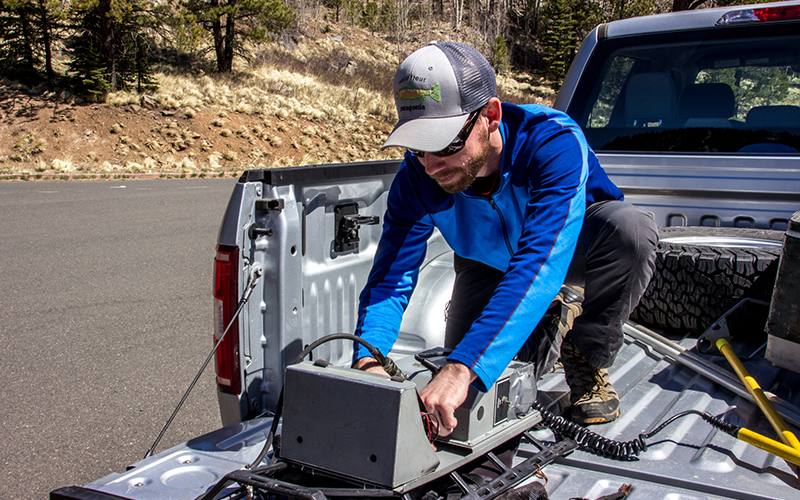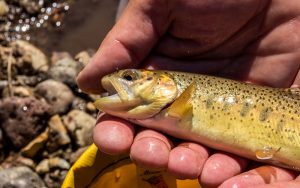
PINETOP – Forest fires, climate change and the wrath of non-native fish are threatening the survival of the Apache trout, a species found only in Arizona.
Apache trout, dubbed the state fish of Arizona, mostly are found mostly near Pinetop, with a significant amount of their territory on Native American reservations. Conservation of the trout has required a decades-long collaboration between the White Mountain Apache Tribe, Arizona Game & Fish Department, nonprofits and the U.S. Fish and Wildlife Service.
“Climate change, the drying out of the forests there, increase chances that there’ll be forest fires, and the general increasing of the temperatures,” said Scott Bonar, the leader of a research cooperative at University of Arizona who has been studying desert fish since 2000.
“When you have a fire, you remove shade to the stream, there is sediment that goes in the stream and hurts the Apache trout,” he said, adding that without certain amounts of water at certain temperatures, the fish die.
To some conservationists, analyzing Apache trout populations, understanding threats to the fish and improving stream conditions is a “biologist’s dream” – but it requires a huge effort.
Arizona Game & Fish employees Bryan Giordano and Mike Lopez are tasked with the Apache trout’s survival in Pinetop. They will walk up shallow streams in tandem, Giordano wearing a large electrofishing backpack plugged into a pole he sweeps in the water. Lopez walks close behind with a net, waiting for Giordano to stun an Apache trout they can catch, examine and safely release.
“Electrofishing is the main technique we use to capture fish,” said Lopez, a fish program manager. “We use it during surveys. It’s a system that puts an electrical shock in the water that stuns the fish temporarily, and we can net them up quickly.”
They quickly catch a trout and place it in a yellow sack filled with water. Lopez gently wraps his fingers around the trout and lifts it up. It’s golden brown with small black dots, an Apache trout.
“It’s not often that a trout species is confined to one state,” said Giordano, a stream biologist.
“The state fish of Arizona, it’s unique,” Lopez added. “They exist nowhere else in the world except for Arizona.”
The tribal, state and federal coalition has had success in downgrading Apache trout from endangered to threatened, a rare victory in the conservation world. But the progress can be fragile.

Droughts and fires
Wildfires can wipe out an entire stream of Apache trout, undoing years of progress, Giordano and Lopez said.
The 2011 Wallow fire, for example, devastated Fish Creek, an area that Game & Fish officials had hoped to reopen to anglers.
“We had Apache trout restocked … the adult population was up over a 1,000 fish, which is pretty significant,” Lopez said. “Then the Wallow fire hit and had some really severe burns in that Fish Creek watershed. And the monsoon following that fire had some pretty intense storms in that watershed. Just blew out that whole stream.”
Even without fires, higher temperatures can make the water too warm for Apache trout, or dry up creeks completely.
“If we’re going to save the species into the future,” Lopez said, “we need to look at some of these larger, more permanent streams. … If you have a larger population and a larger stream, it’s more resilient to these long-term droughts and wildfire.”

“That’s where we’re really starting to butt heads with anglers because now we’re getting into some of those streams that they like to fish,” he added.
Fish and sportfish
Arizona Game & Fish has several methods for eliminating the non-native fish, including brown, brook and rainbow trout, that have displaced the Apache trout.
During the summer, Giordano takes interns into the field to electrofish for hours, analyzing the Apache trout and removing invasive species.
“They’ve barriered off streams, they used mechanical and chemical control to remove non-native fishes that cause problems for the Apache trout,” said Bonar, the UA desert-fish researcher. “They’ve done a very good job of increasing the amount of area where there are Apache trout.”
Game & Fish also builds dams when necessary to separate native and non-native populations, and workers sometimes chemically treat a waterway to kill Apache trout competitors.
These other species either would overpower the Apache trout, driving down their populations, or crossbreed with them, essentially eliminating what makes Arizona’s state fish unique.

“Habitat degradation, cattle grazing, logging, road building, a lot of things like that would impact Apache trout habitat,” Lopez said. “And over time, they just started disappearing and being replaced with these non-native trout species.”
The non-native fish originally were introduced as an extra food source, but the White Mountain Apache Tribe noticed the damage to Apache trout and sounded the first alarm.
Some anglers, however, want to preserve non-native trout populations and continue using the streams they inhabit for sport.
“We have all these balances we’re trying to maintain,” Lopez said.
“I spent a lot of time fishing for brown trout, Mike does as well,” Giordano said. “We try to understand the balance that the sport fish, the non-natives, can provide. But I also have a lot of fun going out and fishing for Apache trout as well.”
Bonar agrees with Giordano, and understands why some anglers don’t want their favorite streams interfered with. But the Apache trout is too special to lose, Bonar said.
“How often do people get a chance to go see rare artwork? People collect rare coins. People have interest in rare things,” Bonar said. “Apache trout is extremely rare. … It’s part of Arizona’s heritage.”
